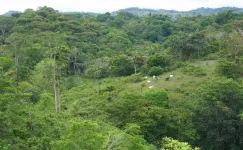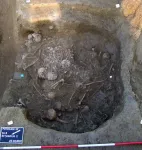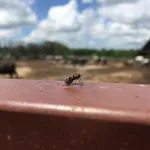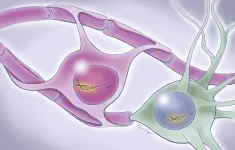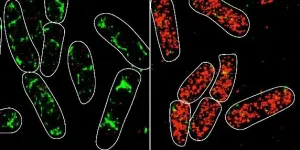Researchers solve more of the mystery of Laos megalithic jars
'Plain of Jars' dates put at 1240 to 660 BCE
2021-03-10
(Press-News.org) New research conducted at the UNESCO World Heritage listed 'Plain of Jars' in Laos has established the stone jars were likely placed in their final resting position from as early as 1240 to 660 BCE.
Sediment samples from beneath stone jars from two of the more than 120 recorded megalithic sites were obtained by a team led Dr Louise Shewan from the University of Melbourne, Associate Professor Dougald O'Reilly from the Australian National University (ANU) and Dr Thonglith Luangkoth from the Lao Department of Heritage.
The samples were analysed using a technique called Optically Stimulated Luminescence (OSL) to determine when sediment grains were last exposed to sunlight.
"With these new data and radiocarbon dates obtained for skeletal material and charcoal from other burial contexts, we now know that these sites have maintained enduring ritual significance from the period of their initial jar placement into historic times," Dr Shewan said.
The megalithic jar sites in Northern Laos comprise one to three-metre-tall carved stone jars, weighing up to 20 tonnes, dotted across the landscape, appearing alone or in groups of up to several hundred.
Dr Shewan and her team completed their most recent excavations in March 2020, revisiting Site 1 (Ban Hai Hin), and arriving back in Australia just before global pandemic international boarder closures.
Site 1 revealed more burials placed around the jars and confirmed earlier observations that the exotic boulders distributed across the site are markers for ceramic burial jars buried below.
Published today in PLOS One, Dr Shewan and collaborators present new radiocarbon results for site use and also introduce geochronological data determining the likely quarry source for one of the largest megalithic sites.
While geologists have used detrital zircon U-Pb dating for several decades, this methodology has recently been used to establish the provenance of ceramic and stone sources in archaeological contexts including Stonehenge.
Conducted at ANU by Associate Professor Richard Armstrong, the U-Pb zircon ages measured in jar samples from Site 1 were compared to potential source material, including a sandstone outcrop and an incomplete jar from a presumed quarry located some 8km away. The zircon age distributions revealed very similar provenance suggesting that this outcrop was the likely source of the material used for the creation of jars at the site.
"How the jars were moved from the quarry to the site, however, remains a mystery," Associate Professor O'Reilly said.
The next challenge for the researchers is to obtain further samples from other sites and from across the geographic expanse of this megalithic culture to understand more about these enigmatic sites and the period over which they were created.
Dr Shewan said this is not an especially easy task given the extensive unexploded ordnance (UXO) contamination in the region where less than 10 per cent of the known jar sites have been cleared.
"We expect that this complex process will eventually help us share more insights into what is one of Southeast Asia's most mysterious archaeological cultures."
The full team of researchers includes La Trobe University, James Cook University, University of Gloucestershire and international collaborators from Laos, New Zealand and Hong Kong.
INFORMATION:
[Attachments] See images for this press release:

ELSE PRESS RELEASES FROM THIS DATE:
2021-03-10
A new study, published this week in Proceedings of the National Academy of Sciences, reveals that nitrogen-fixing trees play an underrecognized role in recovering tropical forests by enriching nutrient-poor soils with scarce elements such as phosphorus and molybdenum.
Coauthor Sarah Batterman, a tropical forest ecologist at END ...
2021-03-10
In previous research, ancient massacre sites found men who died while pitted in battle or discovered executions of targeted families. At other sites, evidence showed killing of members of a migrant community in conflict with previously established communities, and even murders of those who were part of religious rituals.
But a more recent discovery by a research team -- that includes two University of Wyoming faculty members -- reveals the oldest documented site of an indiscriminate mass killing 6,200 years ago in what is now Potocani, Croatia.
"The DNA, combined with the archaeological and skeletal evidence -- especially that ...
2021-03-10
An international research team led by NUST MISIS has developed a new iron-cobalt-nickel nanocomposite with tunable magnetic properties. The nanocomposite could be used to protect money and securities from counterfeiting. The study was published in Nanomaterials.
Presently, research on magnetic nanomaterials with controlled magnetic characteristics is one of the most promising fields. Due to their small size, as well as their excellent magnetic and electric properties these materials have a broad range of potential applications from mobile devices to space technologies.
The new iron-cobalt-nickel nanocomposite was obtained by chemical precipitation, followed by a reduction process.
"This ...
2021-03-10
Researchers hope to use an agricultural pest's genetic code against it to prevent billions of dollars in annual losses in the United States.
Stable flies, or Stomoxys calcitrans, are spotted, tan-colored flies found around the world. They are easily mistaken for the common housefly but for one notable distinction: They bite.
"If you get one in your house and it bites you, it's a stable fly," said Joshua Benoit, an assistant professor of biology at the University of Cincinnati.
Stable flies don't bite so much as chomp. They are the scourge of beachgoers in Florida and recreational boaters in upstate New York. According to Thomas Jefferson, they tormented signatories ...
2021-03-10
DALLAS - March 10, 2021 - UT Southwestern scientists have identified key genes involved in brain waves that are pivotal for encoding memories. The END ...
2021-03-10
Bacteria employ many different strategies to regulate gene expression in response to fluctuating, often stressful, conditions in their environments. One type of regulation involves non-coding RNA molecules called small RNAs (sRNAs), which are found in all domains of life. A new study led by researchers at the University of Illinois describes, for the first time, the impacts of sRNA interactions in individual bacterial cells. Their findings are reported in the journal Nature Communications, with the paper selected as an Editors' highlight article.
Bacterial sRNAs are often involved in regulating stress responses using mechanisms that involve base-pairing ...
2021-03-10
While neurological complications of COVID-19 in children are rare, in contrast to adults, an international expert review of positive neuroimaging findings in children with acute and post-infectious COVID-19 found that the most common abnormalities resembled immune-mediated patterns of disease involving the brain, spine, and nerves. Strokes, which are more commonly reported in adults with COVID-19, were much less frequently encountered in children. The study of 38 children, published in the journal Lancet, was the largest to date of central nervous system imaging manifestations of COVID-19 in children.
"Thanks to a major international collaboration, we found that neuroimaging manifestations ...
2021-03-10
When we recall a memory, we retrieve specific details about it: where, when, with whom. But we often also experience a vivid feeling of remembering the event, sometimes almost reliving it. Memory researchers call these processes objective and subjective memory, respectively. A new study from the Center for Mind and Brain at the University of California, Davis, shows that objective and subjective memory can function independently, involve different parts of the brain, and that people base their decisions on subjective memory -- how they feel about a memory -- more than on its accuracy.
"The study distinguishes between ...
2021-03-10
Aspirin is an established, safe, and low-cost medication in long-standing common use in prevention and treatment of cardiovascular diseases, and in the past a pain relief and fever reducing medication. The use of aspirin was very popular during the 1918 Spanish Influenza pandemic, several decades before in-vitro confirmation of its activity against RNA viruses. Studies showed that aspirin, in addition to its well-known anti-inflammatory effects, could modulate the innate and adaptive immune responses helping the human immune system battle some viral infections.
With this information ...
2021-03-10
Computer engineers at the world's largest companies and universities are using machines to scan through tomes of written material. The goal? Teach these machines the gift of language. Do that, some even claim, and computers will be able to mimic the human brain.
But this impressive compute capability comes with real costs, including perpetuating racism and causing significant environmental damage, according to a new paper, "On the Dangers of Stochastic Parrots: Can Language Models Be Too Big? ?" The paper is being presented Wednesday, March 10 at the ACM Conference on Fairness, Accountability and Transparency (ACM FAccT).
This is the first exhaustive review of the literature surrounding the risks that come with rapid growth of language-learning technologies, said ...
LAST 30 PRESS RELEASES:
[Press-News.org] Researchers solve more of the mystery of Laos megalithic jars
'Plain of Jars' dates put at 1240 to 660 BCE

